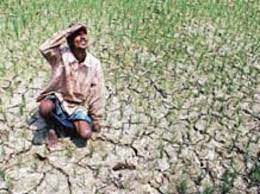NEW DELHI, June 19: Already reeling under the after-effects of tormenting heatwaves, India cannot afford to have a poor monsoon which could spell disaster for its agriculture-based economy, experts have said, hoping a revival of monsoon rains will ease food inflation and ensure food security.
The monsoon accounts for around 70 per cent of the country’s annual rainfall and irrigates 60 per cent of its net sown area. Nearly half of the population depends on agriculture directly or indirectly.
A bad monsoon invariably means bad crop production and inflation.
An early onslaught of heatwaves has already impacted rabi crops, prompting the government to curb wheat exports and cut output predictions by roughly 5 per cent — from 111.3 million tonnes to 106.4 million tonnes.
Another disruption in the weather pattern can have serious consequences in terms of the country’s food security.
While the MeT office has predicted a normal monsoon for the fourth year on the trot, its slow progress in the first half of June sparked fears about a delay in the sowing of crops such as paddy.
However, the weather department says it is expected to pick up pace and compensate for any deficiency.
The prediction is good and the rainfall is picking up. The countrywide rainfall deficit has decreased from 43 per cent on June 11 to 18 per cent on June 17, said Mrutyunjay Mohapatra, Director General (D-G), India Meteorological Department (IMD).
“Normal rainfall activity will continue in peninsular India, east and central parts of the country and the Northeast,” he said, adding that the precipitation in northwest India will increase after June 23.
Mohapatra said monsoon never leads to an even rainfall distribution across all regions.
“If we look at spatial distribution, some areas will get less rainfall; some will get more. The quantum will be normal and that is what we have predicted,” the IMD D-G said.
He said La Nina conditions, considered good for the monsoon, will continue till the end of the season, but will be countered by the projected negative Indian Ocean Dipole (IOD), known for obstructing the progression of the monsoon over India.
“The net result will be a normal monsoon,” the meteorologist added.
G P Sharma, president (meteorology), Skymet Weather, said it looked like the monsoon had hit a roadblock as it entered the third week.
The country received deficient rainfall as far as the agriculture sector is concerned, he said, attributing the sluggish start to the absence of a “driving system like offshore trough, cyclonic circulation, among others”.
But that is going to change soon. A cyclonic circulation will come up over parts of West Bengal, north Odisha and adjoining Bangladesh in three to four days which will change the wind pattern in the Indo-Gangetic plains, the meteorologist said on Friday.
“This cyclonic circulation will initiate the typical easterly flow which is crucial for the advance of the monsoon into northwest India,” he said.
Central parts of the country, including Maharashtra, Madhya Pradesh, adjoining Telangana, Chhattisgarh and Jharkhand, are the core monsoon rain-fed area and therefore, are the most vulnerable.
“Farmers in Punjab and Haryana do not depend on monsoon. They have their resources and irrigation network — tube wells, canals, among others. Whereas central India eagerly waits for monsoon rains,” he said.
A delay in the monsoon poses a greater risk to Maharashtra, as it is a large state stretching from the Konkan coast to Vidarbha and has diverse weather conditions.
“But the situation is becoming better. The disappointing phase has ended at least for the month of June. The rain-fed areas are expected to do well,” Sharma said.
Principal Scientist and Professor, Indian Agricultural Research Institute (IARI), Vinod Sehgal said rainfall deficit will be compensated by the end of June.
“The outlook is good and it appears to be reviving. We should get good rains in July. The situation is not so concerning. A large rainfall deficit that extends into the first week of July is considered disastrous for the Kharif crop,” he said.
A good rainfall is all the more necessary because the prolonged heatwaves have sucked the moisture from the soil, the scientist said.
Sehgal attributed the food inflation to heatwaves and volatile global markets.
Globally, the demand for wheat grew due to the Russia-Ukraine war. The two nations together export a quarter of the world’s wheat.
The increase in crude oil prices and the weakening of Rupee also leads to diversion of a substantial amount of foodgrain for the production of bio-ethanol which in turn leads to food inflation, the IARI professor explained.
Food and trade policy expert Devinder Sharma said deadly heat waves have already hit the wheat yields this year and the country needs a normal monsoon for adequate rice production.
Punjab has 98 per cent of its crop area under assured irrigation. But not all regions of the country have this advantage, he said.
The monsoon has been sluggish in the first part of June, with the rainfall deficit piling up to 80 per cent in some parts of the country. It will certainly impact the yield, Sharma said.
“Reports suggest that the second half of the monsoon will be volatile. Some reports say the rainfall deficit will continue over the next two months. It does not paint a very good picture.
“If the rainfall deficit continues into the second and third week of July, it will have serious ramifications. Let us be very clear, we cannot afford another disruption in the weather pattern. If it happens, we won’t be able to bear the consequences,” he warned. (PTI)
Trending Now
E-Paper


